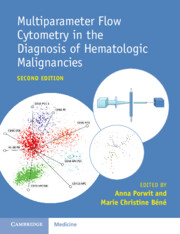Book contents
- Multiparameter Flow Cytometry in the Diagnosis of Haematologic Malignancies
- Multiparameter Flow Cytometry in the Diagnosis of Haematologic Malignancies
- Copyright page
- Contents
- Contributors
- Preface
- Abbreviations
- Chapter 1 Flow Cytometry in Clinical Haematopathology
- Chapter 2 Antigens
- Chapter 3 Flow Cytometry of Normal Blood, Bone Marrow and Lymphatic Tissue
- Chapter 4 Reactive Conditions and Other Diseases Where Flow Cytometric Findings May Mimic Haematological Malignancies
- Chapter 5 Examples of Immunophenotypic Features in Various Categories of Acute Leukaemia
- Chapter 6 Acute Lymphoid Leukaemia and Minimal/Measurable Residual Disease
- Chapter 7 Immunophenotyping of Mature B-Cell Lymphomas
- Chapter 8 Plasma Cell Myeloma and Related Disorders
- Chapter 9 Mature T-Cell Neoplasms and Natural Killer-Cell Malignancies
- Chapter 10 Flow Cytometric Diagnosis of Classic Hodgkin Lymphoma in Lymph Nodes
- Chapter 11 Measurable Residual Disease in Acute Myeloid Leukaemia
- Chapter 12 Ambiguous Lineage and Mixed Phenotype Acute Leukaemia
- Chapter 13 Flow Cytometry in Myelodysplastic Syndromes
- Chapter 14 Future Applications of Flow Cytometry and Related Techniques
- Index
- References
Chapter 6 - Acute Lymphoid Leukaemia and Minimal/Measurable Residual Disease
Published online by Cambridge University Press: 30 January 2025
- Multiparameter Flow Cytometry in the Diagnosis of Haematologic Malignancies
- Multiparameter Flow Cytometry in the Diagnosis of Haematologic Malignancies
- Copyright page
- Contents
- Contributors
- Preface
- Abbreviations
- Chapter 1 Flow Cytometry in Clinical Haematopathology
- Chapter 2 Antigens
- Chapter 3 Flow Cytometry of Normal Blood, Bone Marrow and Lymphatic Tissue
- Chapter 4 Reactive Conditions and Other Diseases Where Flow Cytometric Findings May Mimic Haematological Malignancies
- Chapter 5 Examples of Immunophenotypic Features in Various Categories of Acute Leukaemia
- Chapter 6 Acute Lymphoid Leukaemia and Minimal/Measurable Residual Disease
- Chapter 7 Immunophenotyping of Mature B-Cell Lymphomas
- Chapter 8 Plasma Cell Myeloma and Related Disorders
- Chapter 9 Mature T-Cell Neoplasms and Natural Killer-Cell Malignancies
- Chapter 10 Flow Cytometric Diagnosis of Classic Hodgkin Lymphoma in Lymph Nodes
- Chapter 11 Measurable Residual Disease in Acute Myeloid Leukaemia
- Chapter 12 Ambiguous Lineage and Mixed Phenotype Acute Leukaemia
- Chapter 13 Flow Cytometry in Myelodysplastic Syndromes
- Chapter 14 Future Applications of Flow Cytometry and Related Techniques
- Index
- References
Summary
Acute lymphoblastic leukaemia (ALL) is the most common cancer in childhood but shows a very low frequency in adults. Even in the genomics era, multiparametric flow cytometry is still critical for ALL diagnosis and management. At diagnosis, it determines the proper therapeutic approach through blast characterization and lineage assignment. During treatment, it is an essential tool for response to therapy monitoring through minimal/measurable residual disease detection. Additionally, multiparametric flow cytometry is fundamental in the even more applied immunotherapy setting, recognizing any potential switch of blast immunophenotype.
Keywords
- Type
- Chapter
- Information
- Publisher: Cambridge University PressPrint publication year: 2025

